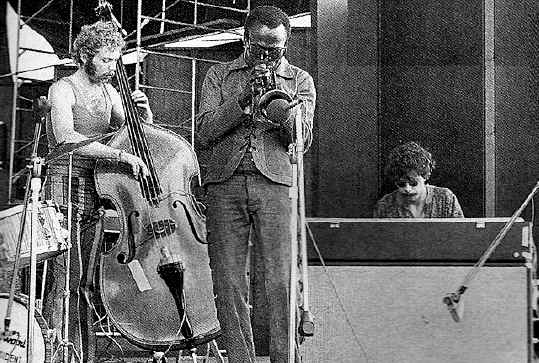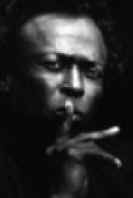
HOME | CONTENTS | SEARCH | POST | REPLY | NEXT | PREVIOUS | UP

From: popeye-x telling you to read Enrico
Merlin's page
30 May 2005 ::: 23:19:07
::: 70.249.47.86
Ever wonder how miles davis' band knew what to do
next?
here's how it worked in the mechanical sense of the live band.
enrico merlin sez:
The method devised by Miles to signal the beginning and end of a number was very simple but extremely effective.
To uncover the system, I started comparing recordings of the various concerts, identifying musical situations similar in key, form and rhythm. I discovered that all the "similar musical situations" were preceded by the same phrase played by Miles Davis on the trumpet.
Having checked this theory carefully, it became clear that these "phrases" were used by the leader during the course of the long medleys to signal the wish to go on to the next piece. In my analyses I have discovered three types of what I call "coded phrase" corresponding to particular characteristics of the relative piece:
For example, in the case of "It's About That Time" the coded phrase is taken from the voicings of the descending chord progressions played by the electric piano (audible at 5:02 of the version published on In a Silent Way) mp3.
As many of the compositions performed in the concerts between 1969 and 1975 were without themes, being based exclusively on a rhythmic idea or on a bass vamp, the coded phrases help us also to correctly identify the pieces. In addition, the bass vamps often underwent substantial changes in the course of the tours (see "Directions" or "It's About That Time") and not even a comparison of the keys is enough to help us, as there are several cases of similar or identical keys (as with "It's About That Time" and "Miles Runs the Voodoo Down").
In August 1969 Miles was back in the studio with a notably bigger band for the recording of Bitches Brew. The technique of the coded phrase as a guiding instrument was even used within one of the pieces on this album: "Spanish Key."
The recording of this number was anticipated by several live performances, in the course of which the whole system was "run in" (modes, bass vamps, coded phrases, breaks, colours). We can appreciate the perfected system on the published version.
"Spanish Key" is characterized by several changes of key that follow one another during the solos (for the structure and the sequence of the solos see appendix 2).
Three modal scales are used: two of darker character (D phrygian and E phrygian) and one of much brighter character (G mixolydian). In the first two scales there is a certain increased ambiguity caused by the use of alternate thirds (major and minor) and a substantially more chromatic approach by the soloists. The modulation from E to G is always anticipated by Corea (probably prompted by Davis), who performs a call break mp3. Modulations are always initiated by the soloist who performs a phrase in the new key, thus signalling his own wish to change the tonal centre.
APPENDIX 2. Structures and sequence of the solos in "Spanish Key":
 The "explicit
verbal instruction" in Miles's music never existed, not even in the
preparation of pieces. This is shown to be true from the conversations I had
with Dave Liebman, Dave Holland, Joe Zawinul, Miroslav Vitous, Bill Evans, Bob
Berg, and John Scofield -- they said that Miles rarely gave any instructions as
to what should be played. From these conversations, it is clear that the
so-called "coded phrases" were never formalized in the sense of a
priori agreements or even arrangements. Anyway these signals existed and
were so clear and efficient that everyone knew which "direction" to
take.
The "explicit
verbal instruction" in Miles's music never existed, not even in the
preparation of pieces. This is shown to be true from the conversations I had
with Dave Liebman, Dave Holland, Joe Zawinul, Miroslav Vitous, Bill Evans, Bob
Berg, and John Scofield -- they said that Miles rarely gave any instructions as
to what should be played. From these conversations, it is clear that the
so-called "coded phrases" were never formalized in the sense of a
priori agreements or even arrangements. Anyway these signals existed and
were so clear and efficient that everyone knew which "direction" to
take.
© Enrico Merlin 1995
ANTI POPEYE X FAN CLUB
HOME | CONTENTS | SEARCH | POST |
REPLY |
NEXT |
PREVIOUS |
UP